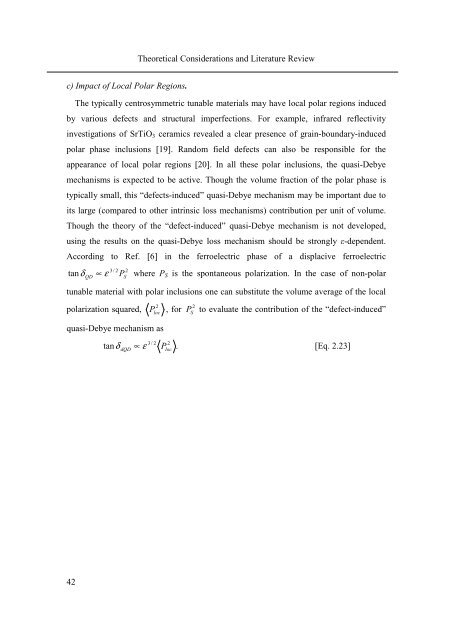PhD Thesis Arne Lüker final version V4 - Cranfield University
PhD Thesis Arne Lüker final version V4 - Cranfield University
PhD Thesis Arne Lüker final version V4 - Cranfield University
You also want an ePaper? Increase the reach of your titles
YUMPU automatically turns print PDFs into web optimized ePapers that Google loves.
c) Impact of Local Polar Regions.<br />
42<br />
Theoretical Considerations and Literature Review<br />
The typically centrosymmetric tunable materials may have local polar regions induced<br />
by various defects and structural imperfections. For example, infrared reflectivity<br />
investigations of SrTiO3 ceramics revealed a clear presence of grain-boundary-induced<br />
polar phase inclusions [19]. Random field defects can also be responsible for the<br />
appearance of local polar regions [20]. In all these polar inclusions, the quasi-Debye<br />
mechanisms is expected to be active. Though the volume fraction of the polar phase is<br />
typically small, this “defects-induced” quasi-Debye mechanism may be important due to<br />
its large (compared to other intrinsic loss mechanisms) contribution per unit of volume.<br />
Though the theory of the “defect-induced” quasi-Debye mechanism is not developed,<br />
using the results on the quasi-Debye loss mechanism should be strongly ε-dependent.<br />
According to Ref. [6] in the ferroelectric phase of a displacive ferroelectric<br />
tan S<br />
3 / 2 2<br />
δ QD ∝ ε P where PS is the spontaneous polarization. In the case of non-polar<br />
tunable material with polar inclusions one can substitute the volume average of the local<br />
polarization squared,<br />
quasi-Debye mechanism as<br />
2<br />
P loc , for<br />
2<br />
P S to evaluate the contribution of the “defect-induced”<br />
3 / 2 2<br />
tanδ<br />
∝ ε P .<br />
[Eq. 2.23]<br />
dQD<br />
loc

















